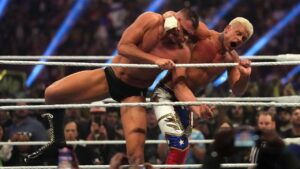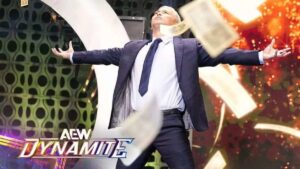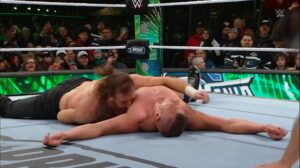The Pioneers is a new on-going series looking at some of the earliest pioneers of professional wrestling as we know it, from the wrestlers to promoters to trainers who helped shape professional wrestling around the world.
The origins of professional wrestling are as muddled as some of WWE’s most recent storylines. While it can be traced back to the ancient Greek times (and further), the choreographed entertainment side that would become professional wrestling as we know it, began in Europe in the early 1800s. In France during the 1830s, a vaudevillian carnival-like attraction arose where audience members would attempt to take down competitors with names like Bonnet, “The O of the Low Alps”. In 1848, French showman Jean Exbroyat formed the first combat circus – or pro wrestling show – and soon his presentation of fanciful grappling swept Europe, from the mainland to the UK. It wouldn’t be long before it made its way to the United States. It was in the Americas, that the sport would be dismantled, reforged, and unleashed back into the world.

During the 1870s, a young boy from Iowa named Martin Burns was making a name for himself in his hometown. Starting at the age of eight, Martin was determined to be a prizefighter – and not in boxing or any other combat sport. He wanted to be a professional wrestler. He would fight kids around the school – many of them older or bigger – and come home with his cash reward, to help out his family’s income. By the end of his teen years, he was a respected shooter, and at age 19, he would finally catch the eye of the first professional wrestler he would meet. A rugged man named Graft would be Burns first mentor and opponent, and although their acquaintance was brief, it would set Burns on a path in professional wrestling.

To keep in top physical condition, he took a job at a grading camp, that led to his amazing and well-documented strength, and he provided entertainment on weekends by taking on all comers in the camp and beyond. His ability to outthink and outmaneuver larger and stronger opponents led to Burns creating his own form of this catch style wrestling. He would make books of notes during this time, that would lead to his future as a trainer. He would wrestle on the pro wrestling carnival circuit as he could and went undefeated for years. His strength wasn’t just in his grip or core strength either – he was renowned for having one of the strongest necks on record. One of his popular parlor tricks was to hang himself by a thick rope, and whistle “Yankee Doodle Dandy” while he swung in the air.

His first loss came in 1886 to Evan “Strangler” Lewis (the name inspiration to early 1900s star Ed “Strangler” Lewis) and it only pushed Burns further. He would take back that loss from Lewis at a later date (as he did another loss in 1887 to Tom Connors). But it was in 1889 that he finally got his big break in the industry. He entered a challenge event in Chicago, that featured Evan “Strangler” Lewis and another era star in Jack Carkeek. An open challenge that paid $2 per minute for every minute you could last in the ring with either star. After initially dodging Burns (after hearing of Burns’ reputation), Carkeek finally relented to a match. Fifteen minutes later, Burns was $25 richer (the maximum payout), as Carkeek was unable to upend Burns.

Martin Burns would go on to become one of the top wrestlers in the United States, and he would headline events around the country. In a huge international showcase, he faced Sorakichi Matsuda, the first Japanese pro wrestler, in New York in 1891 (which he won in four minutes), and by 1895 his star could not be denied any longer. In a rematch against his old foe, Evan “Strangler” Lewis, he became the new American Wrestling Champion, a title he would hold for two years.

In 1899, Martin Burns’ own wrestling career was winding down. That year, he faced – and defeated – a young, hungry wrestler named Frank Gotch, who also hailed from Burns’ home state of Iowa. Although he defeated Gotch handily, there was something about Gotch that Burns was intrigued by this young grappler. Martin Burns made it his mission to fine-tune Gotch and so he did indeed. Nine years later, in 1908, Gotch would defeat “The Russian Lion” George Hackenschmidt to become only the second official World Heavyweight Champion in pro wrestling.

As his in-ring career dwindled, Burns found even greater success as a trainer. Apart from Frank Gotch, his star pupil, he also trained Canada’s greatest early star, Jack Taylor, lightweight star Jack Reynolds, Earl Caddock (the 4th World Heavyweight Champion), Rudy Dusek, Joe Malcewicz, Fred Beel, and Joseph “Toots” Mondt. While those names may not mean much at first glance, a look at some of their legacies shows a bigger reach into today’s pro wrestling.

Jack Taylor was the childhood hero of a young Canadian who had his own aspirations of being a pro wrestler – a young boy from Saskatchewan named Stu Hart. On his own journey to New York City, Stu Hart would catch the eye of another Martin Burns pupil, Toots Mondt, who trained Stu Hart to become a pro wrestler, using primarily Burns techniques. Stu Hart went on to become a great technical wrestler and, just like Burns, a more respected trainer, and teacher. Much of Hart’s own submission and shoot style training was most likely based on principles that had come from Burns.

Joe Malcewicz was a fine wrestler in his own right as “The Utica Panther”, but he’s best remembered as the founder of the San Francisco territory in 1935. It didn’t take long for Malcewicz’s promotion to become the jewel of the West Coast, and in 1949, he joined the National Wrestling Alliance (NWA), where the territory became known as NWA San Francisco. In 1951, they introduced the NWA San Francisco World Tag Team Championship, only the second tag team titles in history, and with their West Coast presence, took tag team wrestling from being a sideshow on the card to being the potential to steal the show.

And while Gotch was ultimately his most successful wrestling pupil, no other pupil did more for pro wrestling than Joseph “Toots” Mondt. After his own in-ring ended, he turned to promote and training as well. As mentioned earlier, he discovered and trained Stu Hart. In 1919, he started training and working with Ed “Strangler” Lewis. Mondt was getting tired of the ad hoc rules of pro wrestling, that seemed to vary from city to city, and even from match to match. Together with Lewis and Lewis’ manager, Billy Sandow, the three became known as the Goldust Trio, and effectively created the blueprint of everything sports entertainment is. Taking elements from catch wrestling, Greco-Roman, freestyle, and more, he created a new style of pro wrestling that was more fast-paced – he also took it from the burlesque halls and barrooms into a boxing ring inside sports arenas.

In 1952, Mondt would join forces with New York City promoter Jess McMahon to form Capitol Wrestling, joining the NWA and controlling the Northeast territory. The union was short-lived – Jess McMahon passed away in 1954 – but it would lead to greater pastures. Jess’ half of the company was acquired by his son, Vincent J. McMahon, and in 1963, Mondt and McMahon would leave the NWA to go it on their own. In doing so, they rebranded as the World Wide Wrestling Federation (WWWF), with “Nature Boy” Buddy Rogers as their new World Champion. The rest, they say is history.

A pioneering man in the history of professional wrestling, Martin “Farmer” Burns went from one of the nation’s greatest grapplers to creating a foundation of technique that defined American professional wrestling, whose students would go on to create a legacy of professional wrestlers that can still be linked to many of today’s modern wrestlers, as well as the creation of the world’s most powerful wrestling organization. A member of multiple wrestling halls of fame, including WWE Hall of Fame (Class of 2017, Legacy Wing), Pro Wrestling Hall of Fame (2003, Pioneer Era), George Tragos/Lou Thesz Professional Wrestling Hall of Fame (2001), and Iowa Sports Hall of Fame (1951). Martin Burns is truly the Godfather of American Wrestling.
Check out more of our articles on The Pioneers of pro wrestling.
Stay tuned to the Last Word on Pro Wrestling for more on this and other stories from around the world of wrestling, as they develop. You can always count on LWOPW to be on top of the major news in the wrestling world, as well as to provide you with analysis, previews, videos, interviews, and editorials on the wrestling world.






